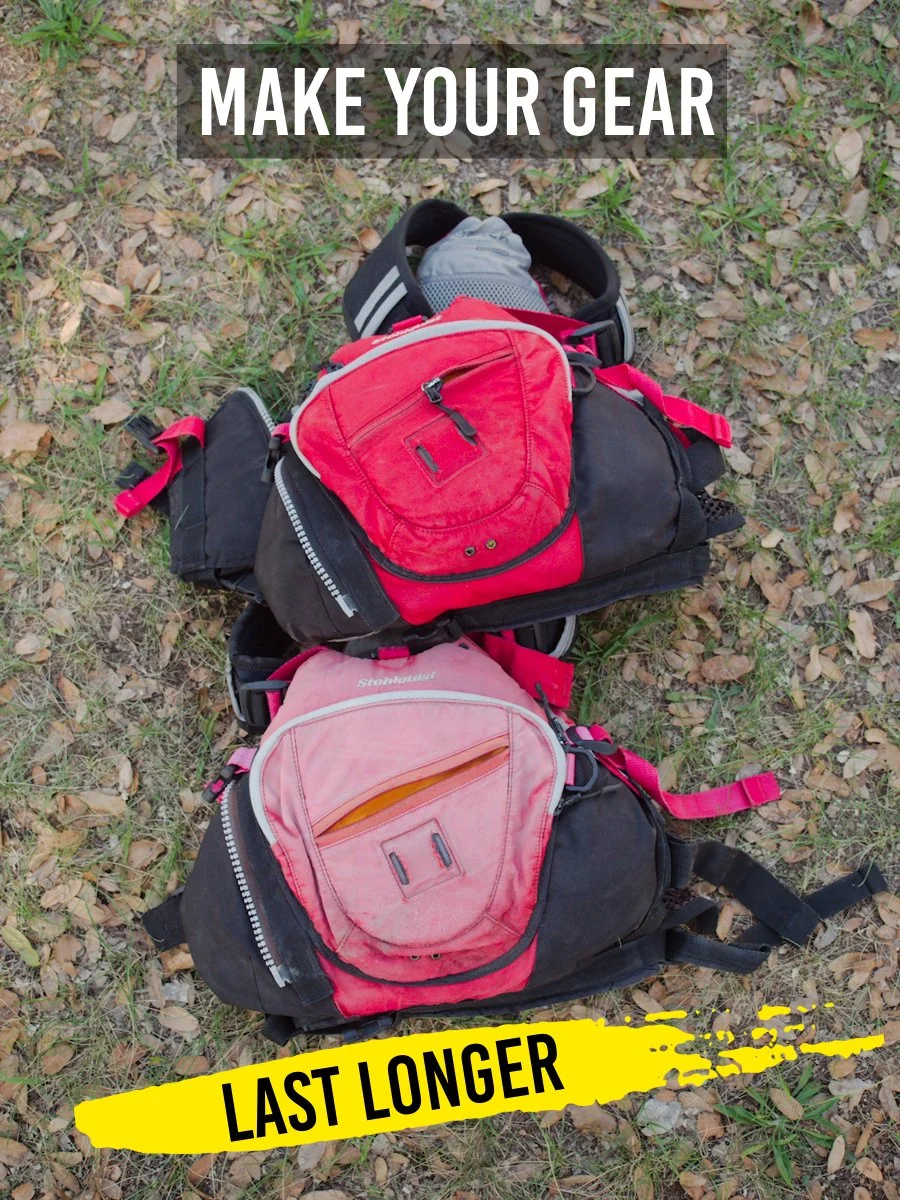How to make outdoor gear last longer
We’ve all been there where we’re stoked on a piece of gear and it’s literally the best thing ever made…then we tear through the buckle, the zipper rips, or the sole inexplicably falls off on a portage. Basically, everything we use out there is a consumable that is not going to hold up to harsh conditions. Now that you have a huge lump of this isn’t gonna work and you buy a new one how does we make that gear last longer?
Change how you use your gear
Sometimes we may not actually know how to use the equipment that we have due to incorrect assumptions or we may have been taught an inaccurate way to use a piece of equipment. If you’re going through a lot of gear really fast then you may want to reevaluate how you use that equipment. Taking time to retrain how you use your gear to get the most longevity out of it can save you a lot of money in the long run. A lot of people are really hard on their gear and you might not be using it in the ideal way to get the most longevity out of it. So how can you change the way you use your gear?
Avoid Overstuffing: Don't overstuff gear seams like drybag, drysuit, or tent seams beyond their recommended capacity. Overstuffing can strain zippers, seams, and fabric, leading to blowouts in your gear.
Proper Storage: You need to let your gear dry and air out. Things like nylon and polyester can actually degrade over time in wet environments. Store your gear in a cool, dry place away from direct sunlight. Avoid storing it in damp, hot, or humid environments, as this can lead to mold, mildew, and fabric deterioration.
Use Appropriate Storage Bags: Consider using storage bags and desiccant packets for clean dry gear that you aren’t using. This can remarkably prolong the life of your equipment by keeping it dry and keeping critters from chewing on it when you aren’t using in the offseason.
Footwear Care: Rotate between multiple pairs of river shoes to allow them to dry completely between uses. Clean and remove sand from your shoes regularly. Replace worn-out insoles to maintain support. You also want to consider spraying them with an anti-fungal from time to time when you are letting them dry after use to decrease foot fungus.
Avoid Direct Heat: This one is especially important in boating because the gear we use often has such a low melting point. Avoid exposing your gear to direct heat sources, such as campfires, heaters, and hot water.
Regular Use: This seems a little counter intuitive, but use your gear regularly. Materials deteriorate over time so using your gear will allow you to actually use it up before the end of its service life.
Proper outdoor gear maintenance
There have been several times, like using 303 on everything, where I was wrong about how to maintain gear appropriately. If you want your stuff to last take some time to really learn from several sources how to best maintain your equipment. If you take the time to think critically you’re going to be able to enjoy the process a bit more and take pride in your gear lasting longer. SO, here’s some tips to keep in mind during your next gear maintenance cycle:
Follow Manufacturer's Instructions: OK, so this one seems super obvious but following care and maintenance instructions provided by the manufacturer is really important. Sometimes people use improper cleaning chemicals on products they are not designed for and in some cases, they can melt the equipment. Things like 303 actually change the chemical make up of the surface of things like PVC and Urethane rafts. If you have to repair your boat, the welds and glues won’t readily bond to the boat after using a chemical like 303 forcing you to grind down the outer layer of your boat to the fabric.
Clean Regularly: Clean your gear after each use to remove dirt, sweat, and moisture. Things like latex gaskets respond horribly to skin oil and especially sunscreen which in turn will melt that latex. Similarly rolling a raft covered in sand is an awesome way to quickly grind through your boat.
Maintain Zippers: Keep zippers clean and lubricated with a zipper lubricant to prevent them from getting stuck or damaged. Often times the zipper is the most expensive part of a drysuit or dry bag and a broken zipper is just cheaper to replace than repair.
Inspect for Damage: Regularly inspect your gear for signs of wear, tear, or damage. Look for loose stitching, holes, fraying, and other issues. If you just take a minute to look over your gear then you’re gonna catch to minor holes early before they turn into bigger problems.
Pack and Handle with Care: Instead of jamming you gear into a stuff sack take some time to pack your equipment. Sleeping bags can get torn or overstressed really easily if it is shoved into a bag.
Repairing gear to get the most out of it.
So, you’ve relearned how to use some stuff and you have also tried to maintain your gear as well as you can. Well unfortunately something is going to break. IF it is a small item, you can probably repair it yourself for a relatively low cost. If you’re looking at a big-ticket item then you may want to send it to the professionals for repairs. Either way keep this in mind when you’re out there wrenching on your gear:
Repair and Maintenance: Learn basic gear repair skills such as patching holes in tents, fixing broken buckles or straps, and sewing minor tears in clothing. If you don’t know how to do this there are a lot of great resources on the internet. Alternatively, you can send larger items like drysuits in for repairs regularly. Our team ships our drysuits back to IR every summer for repairs and by the time it is cold again we have some amazingly fresh suits for the winter.
Weatherproofing: For items like drysuits, PFDs, and rainflys; periodically apply a DWR (Durable Water Repellent) treatment to restore or enhance water resistance. This can also help to prevent particulates floating in the water from embedding themselves in the fibers of your gear and causing microscopic abrasions in the fabric which over time lead to rips and tears.
Seam Sealing: If you have gear with seams (e.g., tents, shoes, or drybags), check your seams and reapply seam sealer as needed to maintain waterproofing and prevent leaks.
Replace Worn-Out Gear
Look we all know that dude who still is wearing that vertical multi chamber PFD from 1980. Cool as it is you need to recognize that outdoor gear has a finite lifespan, and some items will eventually wear out despite the best care. When gear becomes unsafe or unreliable, replace it immediately. Things like PFDs, helmets, and foot wear are critical pieces of safety gear. They call it personal protective equipment for a reason, and if it is no longer protecting you, it is not useful. Is it really worth the risk? If you need some help deciding on the right gear check out the gear shed below:







